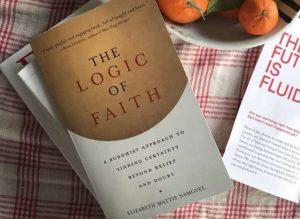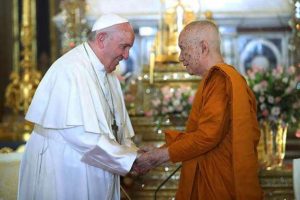
Buddhism has suffered a rather “cosmetic” existence in Western pop music. Whether it is a brand image in Cat Stevens’ “Chocolate Box” or a statuette in Jacques Brel’s “boudoir full of buddhas,” Buddhism is still, to a large extent, a fragile garden ornament in this aspect of mainstream Western culture, among others. At best, it remains a vague, escapist ideal of the sort described by the Spanish band Love of Lesbian in its song “Los Toros En La Wii (Fantástico)” as the search “for a happy world between Buddha or Schopenhauer, of self-help books and the beauty in Murakami.”
The discographies are therefore split into uninformed daydreaming and commercial opportunism. Think of lotus-posture album covers and some multicultural name-dropping, and you get an idea of the somewhat exhausting assortment.
Or is there something else?
Given the focus of Buddhism on sacred sound and recitation, one would be forgiven for imagining some crossover between pop music and the manifold styles of Buddhist chanting across Asia. We know that in Asia this has definitely happened—you can find anything from Buddhist Hybrid Sanskrit temple pop to mantric death metal. In the 1970s, a Japanese acid band that called themselves People devoted their album Ceremony – Buddha Meet Rock (1971) to a recitation of mantras and “prayers,” with a fascinating shōmyō–inspired monotony.
Sought after by progressive rock fans ever since, Ceremony is an early example–along with the work of Stomu Yamashta—of Japanese psychedelia’s long-standing fascination for things Buddhist, which culminates in the Acid Mothers Temple’s repetition of the mantra “Namu Myōhō Renge Kyō” for an entire album. It is a pity that People’s pioneering Buddhist production begins and ends with a breach of the second precept (refraining from stealing), as the prologue and epilogue include uncredited samples from David Axelrod’s album Song of Innocence (1968).
In postwar Europe, the most fertile ground for traditional Buddhist practices such as meditation and chanting sutras could be found in Germany’s signature amalgamation of kraut, progressive rock, proto-electronica, and ambient music. As in the previous decade, Hinduism won the day, but the German sonic pioneers did not forget Buddhism completely. In Buddhist Meditation East and West (1975), electronic composer Peter Michael Hamel (from Between) recorded “homages to Amitābha Buddha” and “Shunyata – From Whence I Came.”
A kind of album that became more common in the 1980s, heralding the worldwide obsession of instrumental electronic music with Buddhist imagery, which goes far beyond the confines of Goa Trance. Explorations like Klaus Wiese’s album Mahakala-Puja (1985), which is described as “a Mantra-Meditation that works at the level of the 4th and 6th chakra,” nourished this more progressive, experimental niche.
During the 1980s, interest in Buddhism grew slowly across different genres and audiences, especially in the US. Even the underground punk scene had its share of Buddhist practitioners, some of whom went on to become teachers and advocates (examples that come to mind are Brad Warner, Noah Levine, or Glenn Wallis from the band Ruin). Nevertheless, Buddhism was still perceived as something more suitable for jazzmen or minimalist composers, and pop lyrics seldom mentioned it.
It was only during the 1990s when we started seeing major pop musicians engaging in Dharma study and practice. Fluid identities were the norm in this game, and it was not always clear if the artist ever took formal refuges, precepts, or vows. There was, however, some intensity to that era.
Without abandoning his ancestral Jewish identity, the late Leonard Cohen spent his time between 1994 and 1999 in a Zen monastery. Singer Tina Turner, who passed away in 2023, and Courtney Love practiced with the Japanese organization Soka Gakkai. Another pioneer in this field was jazz musician Herbie Hancock, who has been chanting the aforesaid “Namu Myōhō Renge Kyō” mantra since at least 1972. Amanda Palmer led the late Lou Reed to become one of the “bad” Buddhists, and is one of the few artists who has published reflections on the tensions between the meditative mind and the creative mind (they exist!).
The fact remains that most pop stars of a Buddhist persuasion never sang about it. While a maestro like the late Franco Battiato did eventually author a documentary film and a book around the theme of the Tibetan bardo, he was an exception to the rule. Of course, one should not expect too much religious devotionalism in a pop music record, but even Buddhism’s massive storehouse of stories and archetypes is yet to be discovered by mainstream lyricists (a recent exception is Nick Cave’s harrowing “Hollywood”).
Some artists left behind their Buddhist “phase,” some alternated, and some were just experimenting or playing around. Freak folkie Devendra Banhart jokes about his own hedonic, so-called “Buddhist vehicle” of “Rasayana.” (supposing this term can be transliterated as rasayāna)
Karmic chameleon Boy George describes himself as “Catholic in my complications and Buddhist in my aspirations.” The widespread sympathy for the current Dalai Lama only muddles the discernible affiliations: on the occasion of His Holiness’s 80th birthday, a non-profit album was released containing unexpected names such as Kate Bush, Peter Gabriel, and Sting (who is another complicated Catholic. Someone who did write Buddhist music, in that golden age of the 1990s, was rap rocker Adam Yauch from the Beastie Boys. Previously identified with booze, go-go cages and raucous party anthems, Yauch wound up apologizing in song for his former misogynistic persona, campaigning for Tibet, writing verses about the bodhisattva ideal, and rapping them with characteristic passion:
For the sake of all beings I seek / the enlightened mind that I know I’ll reap. / Respect to Shantideva and all the others who brought down the Dharma / for the sisters and brothers
From rap’s party crasher to student of the bodhisattvas: this is as steep as learning curves go. This could be an example of the Dharma bringing someone to their full potential, as has happened for many other less famous people.
Buddhism has long been perceived as a pacifier of agitated souls. Think of the fierce Mauryan emperor Ashoka (c. 304–232 BCE), the leaders of the Mongol Yuan dynasty (1271–1368), and now, musicians, actors, and wild literati. Although sometimes accused (unfairly) of a certain blindness to beauty, Buddhism gets along surprisingly well with the Bohème. This is a mutual affinity that remains ambiguous and contested. But, when Buddhism is permitted to raise its voice, it is to remind the superstar that his or her lifestyle needs serious reflection.
See more
Melody vs. Meditation (Lion’s Roar)
Various (Discogs)
Related features from BDG
Marijuana and Nirvana: Buddhism and Pop Music, Part One
Buddhistdoor View: European Decline – Why is Buddhism the Continent’s Fastest-Shrinking Faith?
Dharma: The Taiwanese Buddhist Death Metal Band











